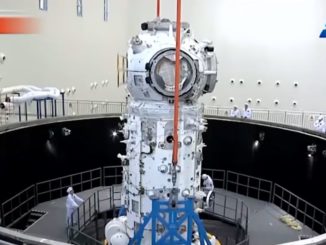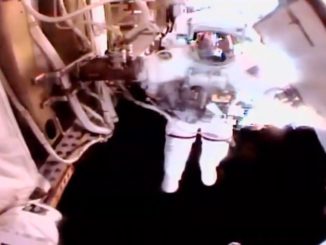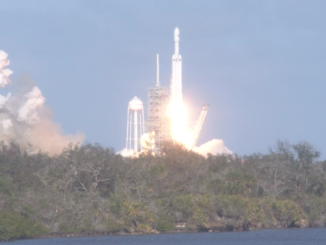
If all goes according to plan, engineers in southern Mississippi later this month will load cryogenic propellants into the core stage of a rocket NASA says will launch astronauts back to the moon, exposing its tankage and internal plumbing to extreme operating conditions hundreds of degrees below zero for the first time.
The fueling test — a major milestone in its own right — is a precursor to a high-stakes eight-minute test-firing of the Space Launch System’s four shuttle-era main engines planned as soon as November.
Covered in orange foam insulation, the huge Boeing-built rocket stage has been fastened in the B-2 test stand at NASA’s Stennis Space Center since January, when it arrived by barge from a manufacturing plant at NASA’s Michoud Assembly Facility in New Orleans.
Since January, work to ready the rocket stage for its first test-firing has been suspended several times, first by the coronavirus pandemic, and then by several close calls with hurricanes approaching the Gulf Coast.
With Hurricane Delta on track to make landfall in Louisiana Friday, hands-on work on the SLS core stage has again been paused on the B-2 test stand, according to Valerie Buckingham, a NASA spokesperson at the Stennis Space Center.
But Stennis is expected to receive limited impacts from Hurricane Delta, and assuming the forecast holds up, operations on the test stand could quickly resume.
The next step in the SLS test campaign at Stennis, known as the “Green Run,” will be to load 733,000 gallons of super-cold liquid hydrogen and liquid oxygen into the core stage. NASA expects that major step to occur later this month, according to Tracy McMahan, a spokesperson at the Marshall Space Flight Center, which manages the Space Launch System program.
Numerous sensors will measure how the core stage and its intricate plumbing respond to the loading of cryogenic propellants.
The liquid hydrogen is stored at minus 423 degrees (minus 253 degrees Celsius) in the case of liquid hydrogen, and liquid oxygen is kept at minus 298 degrees Fahrenheit (minus 183 degrees Celsius).
The fueling test, known as a wet dress rehearsal, is the penultimate test in the Green Run. If everything checks out in the wet dress rehearsal, engineers will load cryogenic propellants into the core stage again in November and ignite the rocket’s four RS-25 main engines for more than eight minutes, the duration of their burn during a real launch.
The hotfire test is a final exam in the development of the core stage, the tallest rocket stage ever built. The SLS core is derived from the space shuttle external tank, and its four RS-25 engines — built by Aerojet Rocketdyne — are leftovers from the shuttle program.
The 212-foot-long (64.6-meter), 27.6-foot-wide (8.4-meter) SLS core stage has the same diameter as the shuttle’s fuel tank. It weighs about 188,000 pounds (85 metric tons) empty, and will weigh around 2.3 million pounds (more than 1,000 metric tons) fully fueled.
After the core stage arrived at Stennis in January, ground teams lifted the rocket by crane and lowered it onto the B-2 test stand, a facility once used for test-firings of the powerful first stage of NASA’s Apollo-era Saturn 5 moon rocket.
The first major test on the core stage was a modal test on the core stage to measure the resonant frequency of the rocket.
In March, NASA halted operations on the test stand for two months with the onset of the coronavirus pandemic. NASA and Boeing engineers resumed work on the core stage in May after introducing new guidelines for physical distancing and other measures to guard against COVID-19.
Ground teams switched on the core stage’s avionics in June and performed a thorough checkout of the rocket, then proceeded into safing checks, which verified controllers can send commands to shut down the rocket’s engines and other major systems in the event of a problem.

Then engineers commenced testing of the core stage’s main propulsion system, searching for any signs of leaks and verifying all connections between the engines and the rocket’s tankage. That test, known as Test 4 in the Green Run, also included engine igniter checks and tests of the engine control valves.
With that test passed successfully over the summer, teams moved on to a checkout of the core stage’s hydraulic system, which drives thrust vector control actuators to swivel the four RS-25 engines and steer the rocket in flight.
Teams activated the rocket’s auxiliary power units, which drive the hydraulic loops for engine steering system. The engines then gimbaled individually to ensure they could be swiveled within an 8-degree cone, followed by gimbal test profiles to simulate how the engines will move together in flight.
The hydraulic thrust vector control test concluded Sept. 13, wrapping up a series of functional checks on the rocket as engineers moved into final reviews and rehearsals for the wet dress rehearsal and hotfire.
The next milestone, known as Test 6, was completed Oct. 5 after control teams at Stennis ran through a simulated 48-hour launch countdown to validate activation, fuel loading, and pressurization sequences.
Engineers and technicians from NASA, Boeing, and engine-builder Aerojet Rocketdyne participated in the countdown simulation, which provided a “refresher course” for test controllers to ensure they are ready to load cryogenic propellants into the rocket for the first time, according to Mark Nappi, Boeing’s Green Run test director.
“Once we’re done with that, we’ll stop, we’ll break, we’ll review the data, and we’ll go into the actual wet dress rehearsal,” Nappi said in an interview before the countdown simulation test.
NASA has not announced a target date for the cryogenic loading test, but it will mark a significant step for the SLS program, a milestone that comes with unknowns.
“Filling everything with cryo is huge because that’s the first time you have your tanks moving the way they’re going to move when they’re filled with cryo fluid,” said Alex Cagnola, a propulsion engineer at NASA’s Marshall Space Flight Center.
“You’re testing all your joints. You’re testing how everything basically acts under a cryogenic environment,” Cagnola said in an interview earlier this year.
John Shannon, SLS program manager at Boeing, said all of the testing on the rocket so far has been at ambient temperatures
“Things change when you get down at cryogenic temperatures, and as we saw after our experience with the shuttle, you can end up having systems perform differently,” said Shannon, a former NASA flight director and space shuttle program manager.
Teams will check for leaks, and ensure valves and other hardware still work at cryogenic temperatures. It takes about six hours to pump liquid hydrogen and liquid oxygen into the core stage.
“The next big unknown as a program is when we put the cryogenic liquids in the oxygen tank and the hydrogen tank, and we look at the plumbing and all the systems and make sure that they remain tight, and that they perform as expected through our qualification test,” Shannon told reporters earlier this year. “We have high confidence that they will, but until you see it in an integrated fashion, you don’t really know.”
Engineers will drain the core stage of its cryogenic propellants after the wet dress rehearsal, then analyze the test results and perform inspections of the rocket before proceeding with another fueling operation. That will culminate in ignition of the rocket’s four RS-25 engines.
All four engines on the SLS core stage have flown on multiple space shuttle missions, and the high-performance powerplants will provide up to 2 million pounds of thrust at full throttle. The reusable engines on the single-use core stage will be discarded after each SLS flight.
The RS-25 engines will fire for more than eight minutes. Programmed commands will adjust the engines’ power settings during the test, mimicking their thrust profile during launch.
Assuming a successful hotfire test, teams at Stennis will prepare the core stage for shipment to NASA’s Kennedy Space Center — likely early next year — for final processing to ready the rocket for its first test flight in late 2021.
Inside the Vehicle Assembly Building at Kennedy, technicians will begin stacking the rocket’s twin solid rocket boosters on a new mobile launch platform once the core stage passes its Green Run hotfire test. After arriving at Kennedy, the core stage will be lifted in between the solid-fueled boosters, then ground teams will raise an upper stage and an Orion crew capsule on top of the rocket before rollout to pad 39B for a countdown rehearsal and final launch preparations.
The first flight of the Space Launch System with the Orion spacecraft, known as Artemis 1, will not carry any astronauts. The Orion will fly to the moon and enter lunar orbit to demonstrate its performance and capabilities, then return to Earth for a splashdown in the Pacific Ocean after a mission of 26 to 42 days.
In 2023, NASA aims to launch the Artemis 2 mission with a crew on-board. After blasting off on the second SLS flight, the Orion crew will loop around the far side of the moon before coming back to Earth, the first trip by astronauts to the vicinity of the moon since 1972.
If NASA’s plans come to fruition — an open question that hinges on funding from Congress and no major technical obstacles — the Artemis 3 mission could launch by the end of 2024 on the third SLS/Orion mission. After flying their Orion spaceship near the moon, astronauts would link up with a commercial lunar lander to travel to the moon’s surface for a landing attempt.
In April, NASA contracted with commercial teams led by Blue Origin, Dynetics and SpaceX to begin developing human-rated lunar landing craft. The agency expects to select one or two of the teams next year to continue lunar lander development efforts, assuming Congress provides the money to support the effort.
The SLS and Orion programs stretch back years.
The Orion spacecraft has its roots in NASA’s Constellation moon landing program started under the George W. Bush administration. NASA chose Lockheed Martin as the prime contractor for the Orion crew capsule in 2006, and Orion survived the cancellation of the Constellation program by the Obama administration in 2010.
The Space Launch System was unveiled in 2011 as the centerpiece of a new space exploration initiative proposed by Congress. The Obama White House signed on to the program, and NASA repurposed the ongoing Orion spacecraft work to support a broader exploration strategy focusing on Mars, not the moon, with intermediate missions involving visits by astronauts to asteroids in deep space.

Despite years of delays and cost overruns, the Space Launch System has retained support from lawmakers, particularly among members of Congress from states where the rocket is designed, built, and tested. The Trump administration redirected NASA’s space exploration strategy toward the moon, creating the Artemis program after a directive from Vice President Mike Pence last year to land astronauts on the moon by the end of 2024.
NASA has spent more than $15 billion on the SLS program to date, and NASA’s inspector general warned in March that the rocket’s development costs will increase to more than $22.8 billion by 2023, when the agency expects to certify it for astronaut flights.
The SLS core stage is the last major element for the Artemis 1 mission yet to be delivered to the spaceport in Florida for launch processing. The Orion spacecraft has completed its test campaign, and is ready to be fueled and mated with its launch abort system. Managers will give the go-ahead for those activities after the core stage completes its Green Run hotfire test.
Segments for the rocket’s twin side-mounted solid boosters arrived at Kennedy in June from their Northrop Grumman factory in Utah. Technicians plan to start stacking the boosters on mobile launch platform in the Vehicle Assembly Building once the Green Run testing on the core stage concludes in Mississippi.
Email the author.
Follow Stephen Clark on Twitter: @StephenClark1.



